The path from the tank "Christie" to the BT-2
The transformation of the American prototype into a serial Soviet tank
18 July 1929 of the USSR Revolutionary Military Council approved a new "Red Army Tank-Tractor and Armored Arms System", which approved the organization of armored weapons of the Soviet Union, as well as the classification of tanks and their functions in future military conflicts:
- reconnaissance tank - fast, all-terrain, cheap combat vehicle (tank or wedge), possibly floating;
- a combined arms tank - the main tank of the Workers 'and Peasants' Red Army;
- operational tank - breakthrough tank, he had not to be drawn into battles with tanks and anti-tank artillery of the enemy, but to go into the breakthrough with troops on armor and develop an offensive, destroying the enemy’s rear;
- tank quality amplification TRGK (tanks reserve of the main command) - a powerful medium tank with strong weapons;
- powerful special purpose tank also belonged to TRGC. It was a heavy breakthrough tank with powerful artillery weapons capable of withstanding enemy anti-tank artillery fire.
At that time, the Soviet Union almost did not produce tanks that would meet the requirements. The country had to create an entire tank industry from scratch, train and train specialists (design and production personnel), prepare an industrial base and design bureaus to provide the army with modern armor in a short time. 22 November 1929 was established in the country by the Department of Motorization and Mechanization of the Red Army, the first head of which was Commissar I. A. Khalepsky. He was an ardent supporter of accelerating the production of tanks in the USSR through the acquisition and licensing of the latest types of equipment abroad. For the Soviet tank building such an approach he considered a kind of "doping."
6 December 1929 of the year Sergo Ordzhonikidze, who was the chairman of the head of the People's Commissariat of Industry, made a decision on the allocation of funds for the purchase of foreign tanks. Already 30 of December of the same year, the procurement commission under the leadership of Halensky and the head of the engineering department of UMM S. A. Ginzburg went to the USA, where she held talks with the American designer, inventor and businessman John Walter Christie about the possibility of buying several copies of his M1931 tank and the subsequent Licensing of tank production in the Soviet Union. This combat vehicle was largely advanced in terms of applied design solutions. In the tank there was a suspension, which was patented by Christie, the dense layout of the units, the use of welding when assembling the hull, the transverse arrangement of the engine. In addition, the tank could move on wheels (on the highway) and on tracks (over rough terrain). At that time, it was the fastest tank in the world (the speed is more than 70 km / h on wheels and more than 45 km / h on tracks).
At the same time, members of the commission had a double impression about the tank: on the one hand, they were impressed by the speed characteristics of the combat vehicle, on the other hand, the role of the “operational tank”, where it was chosen, was not suitable. Perhaps the situation then turned the interest in the tank from the Polish military. Marian Rusyn, the captain of the Polish army, even before the Soviet delegation visited the United States, visited Christie’s enterprise, where he was shown the prototype of the M1928 tank and the design of its upgraded version of the M1931. The Pole was so pleased with the combat vehicle that a delegation led by the head of the Military Institute for Design Research (WIBI), Colonel Tadeusz Kossakovski, arrived in Poland on February 26. She signed an agreement with Christie for the delivery of the finished tank and the license for its release in Poland. In this case, the Poles made an advance in the amount of 50% of the cost of the tank.
To the surprise of the Polish side, the Americans terminated the contract unilaterally, returning an advance. The reason was the decision of the Soviet side to buy the Christie’s M1931 tank, all the more so since the matter of creating their own “operational tank” in the country did not work. The design of the T-24 tank and its introduction into production at KhPZ was very slow. But, apparently, the main reason for the termination of the US-Polish treaty was the strong desire of the Soviet side, which, until 17 September 1939, considered Poland as the main likely enemy. The presence of the Polish army’s own fastest tank in the world was not included in the plans of the Soviet military and the country's leadership, so they did not spare the money to outbid the tank and take it out from under the nose of the Poles.
In the US, two M1931 tanks were ordered with a total value of 60 thousand dollars, as well as spare parts for them for the sum of 4 thousand dollars. Another 100 thousand dollars the Soviet Union pledged to pay for the right to produce these tanks for 10 years. Christie had to personally come to the USSR to assist in setting up the serial production of his tank, however, being a real capitalist, the American inventor treated the world's first socialist state, to put it mildly, not quite approvingly. It is possible that the designer was forced to conclude this deal by the very difficult financial circumstances in which he found himself at that moment in time, due to the refusal of the American army to purchase tanks for its design.
The M1931 was shipped from the US to the Soviet Union on 24 December 1930. Diplomatic relations between the countries at that time were still absent, so the company Amtorg Trading Corporation, a joint-stock company registered in New York State for Soviet capital and specialized in the purchase and supply of the latest equipment, weapons and technology in the USSR, was involved in the delivery. In the Soviet Union, the tanks arrived without towers, in addition, the set of documentation by the Americans was not transferred in full. But in this situation, the Soviet side was helped out by the foreign intelligence service - the missing tank drawings were secretly acquired from Christie's assistants and forwarded to the USSR. As a result, 25 was not paid thousands of dollars to the American, but in response he refused to go to the Soviet Union, on this the cooperation between Christie and the Soviet Union ended.
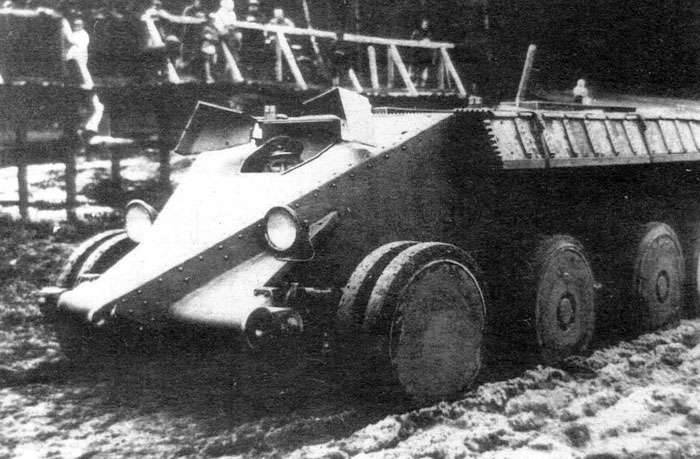
At the beginning of 1931, the tanks were in the USSR, for the purpose of secrecy, the machines received the designation “Original 1” and “Original 2”. One of the arrived tanks was disassembled for a thorough detailed study, and the second was sent for ground tests. To simulate the missing tower on the body of the combat vehicle placed an additional ballast weight 800 kg. 14 March 1931, the tank was shown to the representatives of the command of the Red Army, making a favorable impression on them. In May-June, the 1931 of the year, Christie's tanks passed tests in the Soviet Union, based on the results of which a report was drawn up that required improvement of the design and elimination of a number of flaws in the combat vehicle. This made it impossible to directly copy the tank, as the Soviet leadership had originally planned. Tower of a tank with artillery weapons in general had to create from scratch. To finish the American tank, a special design bureau was established under the direction of N. M. Toskin. Nikolai Mikhailovich Toskin - military engineer of the 2 rank - erudite and energetic engineer made a great contribution to the creation and refinement of the design of the BT-2 tank, as well as the formation and development of the tank design bureau at the KhPZ.
It was in Kharkov that they decided to establish the production of a new tank, which received the designation BT-2. The production of a new tank at the KhPZ began in early 1932. Serial production of light wheeled tracked tanks BT-2 immediately faced a lot of different difficulties. At that time, the USSR was just beginning to master fully heavy industry. For the production of an advanced tank at that time, the country literally lacked everything - machine tools, trained personnel, and high-quality materials. There were problems with the release of high-quality armor and the formation of towers and buildings from it. There were problems with the engines, the production of the M-5 was discontinued. Engines began to be installed on the tanks, having exhausted their resource in aviation, also in the United States had to urgently purchase stocks of the already outdated Liberty engine. Problems arose with artillery weapons, Soviet industry could not arrange the release of the 37-mm B-3 guns in the proper volumes.
Despite all the difficulties, the American got accustomed to the USSR. Thanks to the efforts of the Soviet designers and engineers, he turned into a serial light tank BT-2, the first in a numerous line of BT tanks. As production problems are resolved, its release in Kharkov grew. In 1932, 396 tanks were assembled here, in 1933, 224 combat vehicles (total 620 tanks). Production of the BT-2 was discontinued due to the launch of the production of a more advanced BT-5, which received a new turret with an 45-mm tank gun.
The design of the tank BT-2
BT-2 was an unusual tank. It can be safely attributed to combat vehicles with the highest power density - 35,4 horsepower per ton. For example, in the T-80 tank, this indicator was 27,2. At the same time, their maximum speed on the highway was approximately comparable - 70 km / h (BT-2 could develop such a maximum speed when driving on a wheel track). The landmark was for the Soviet tank building and suspension design Christie, which was used on the BT-2. She defined the development of domestic tank building for the next 15 years - all light tanks of the BT series and the subsequent medium tanks T-34 and T-34-85 were equipped with just such a suspension. They abandoned it only at the very end of the war, when the T-44 and T-54 tanks were created in the USSR.
BT-2 was a lightweight single-wheeled wheeled-tracked tank of the classic layout, equipped with cannon and machine gun weapons and has anti-bullet armor. From the bow to the stern, the tank could be divided into 4 units: control, combat, power and transmission. The power was separated from the fighting compartment by a partition with gates (doors), behind it there was a transmission compartment, also separated by a partition with a cut-out for the fan.
The armor protection of the tank was anti-bullet, it provided protection against small-arms bullets. weapons, as well as fragments of shells and mines of small and medium caliber. The hull of the tank was assembled from armor rolled sheets of thickness 6, 10 and 13 mm. The forehead, the tower and the sides of the hull had an 13 mm reservation, the feed - 10 mm, the bottom of the hull - 6 mm. The armored hull of the tank served at the same time as the frame on which all its mechanisms were mounted. The case was box-shaped and assembled on rivets from individual armor plates. To ensure the rotation of the front steering wheels, the front of the tank hull was narrowed laterally. The nose part of the combat vehicle consisted of a steel casting, to which the front armor plates and bottom were riveted and welded. In addition, the casting served as a crankcase for mounting the arms and steering rack. The tank turret had a cylindrical shape and was riveted, its front part was chamfered.
The tank crew consisted of a 2-3 man. The driver was located in the control center in the nose of the combat vehicle. The commander of the combat vehicle, he is the gunner and loader, was in the fighting compartment in the middle part of the tank hull and turret. The crew consisting of 3-x people, as a rule, had a BT-2 tanks with cannon armament. In this case, the tank commander served as a gunner, and the third crew member - the loader and machine gunner. The landing and disembarking of the crew members from the tank was carried out through the hatch of the mechanical input and the hatch in the roof of the tower.
The power plant of the tank was represented by the 12-cylinder aviation four-stroke carburetor V-shaped liquid-cooled engine of the Liberty brand (or its analogue M-5-400 produced in the Soviet Union). The maximum power of this engine was HP 400. (294 kW) at 1650 rpm The engine was started either with two “MACh” electric starters with a power of 1,3 hp. each, which were mounted on the gearbox, or by a single “Scintilla” electric starter with an 2 horsepower, was also possible to start the engine manually using the crank.
Transmission BT-2 tank was mechanically, it consisted of a multiplate main clutch dry friction (steel on steel), a four-CAT (4 forward and one backward), two single-stage final drive two multi-drive steering clutches with band brakes and two pinion gears ( guitars) drive to the rear support rollers - leading during the wheeled course of the combat vehicle.
The BT-2 tank was equipped with an individual spring (“candle”) suspension, which later became widely known as the “Christie suspension”. With respect to each side of the tank, there were 3 vertical springs between the outer armor sheet and the inner wall of the hull side, another spring was placed horizontally inside the hull in the tank compartment. The vertical springs were connected to the rear and middle support rollers via balancers, and the horizontal springs - to the front controlled rollers of the tank.
The tank BT-2 was distinguished by the presence of a combined wheel-tracked drive. Its chassis consisted of a pair of front guide wheels with a diameter of 550 mm, a pair of rear driving wheels with a diameter of 640 mm and four pairs of dual track rollers having a diameter of 815 mm. Support rollers of the tank were equipped with rubber bandages. Each tank track consisted of 46 tracks, 23 of which were flat, and 23 - equipped with one ridge, the width of the track was 263 mm. The transition of the BT-2 tank from a tracked to a wheeled one was made by the crew of the combat vehicle in 30-40 minutes - in this case the drive was transferred to the rear pair of road wheels, and the front pair became the driving wheels. During the transition from caterpillar to wheel travel, each caterpillar was separated by the crew of the tank into 4 units and placed on the fencing shelves, after which it was fastened with straps in three places.
The main armament of the BT-2 was the 37-mm B-3 gun with a wedge gate. This gun had German roots. 28 August 1930 of the year, through the German front firm Byutast, specially created to work with the Soviet Union, the USSR acquired 6 artillery systems from the German company Rheinmetall, including the 37-mm anti-tank gun, which in the near future was to become known anti-tank gun 3.7cm PaK 35 / 36, the most massive in the German army to 1942 year. The Soviet counterpart of this instrument received a factory index 1-K. The gun was made at the Moscow-based plant number XXUMX Kalinin. At its base, a tank gun B-8 (factory index 3-K) was created, which was mounted on BT-5 tanks.
The gun B-3 allowed to fire fragmentation shells at a distance of up to 2000 meters, with a combat rate of fire of 12-15 shots per minute. An armor-piercing projectile of this 37-mm gun had an initial speed of 700 m / s and pierced the normal 1500-mm armor at a distance of 13 meters. The auxiliary armament of the BT-2 tank was an 7,62-mm DT machine gun, which was mounted in a separate ball bearing located to the right of the gun. Targeting a cannon and machine gun on a target in a vertical plane was carried out using a shoulder rest, and the turret was rotated in a horizontal plane using a planetary hand-operated turning mechanism. The tank ammunition included an 92 shot to the gun and 2709 ammunition (43 disk on the 63 cartridge).
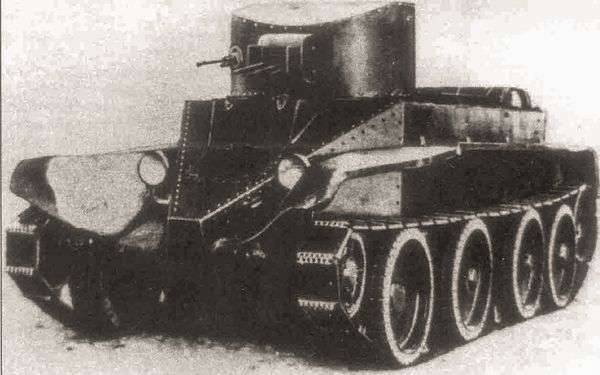
However, the development of the B-3 tank gun by the Soviet industry took place "with difficulty". Therefore, all 208 tanks (according to other 180 data) were made of cannon tanks, of which 60 combat vehicles had only gun armament (did not have a DT machine gun). As a result, most of the BT-2 tanks had only machine-gun armament, such tanks were 412. As the main armament they used a twin machine gun installation YES-2 7,62-mm caliber. Initially, on the part of the tanks armed with this installation, the autonomous 7,62-mm DT machine gun was kept in the ball mount, but later, due to the inconvenience of using two machine-gun installations, it was simply dismantled, and an armored stub was installed in its place.
As a result, the BT serial tanks, which produced only 620 units, had the 4 version of the installed weapons:
- cannon (only 37-mm gun B-3);
- cannon-machine gun (37 gun B-3 + 7,62-mm machine gun DT in ball mounting);
- machine gun (twin machine gun installation YES-2);
- enhanced machine-gun (twin machine gun + DT machine gun in ball mounting).
There was simply no special means of observation and communication on the BT-2 tank. In a combat situation, the mechvod monitored the terrain through the viewing slot, and the commander through the scope. Radio stations were not installed on the tank; combat vehicles were supposed to support external communication using flag signals. For this, a special hatch was placed in the tower. Internal communication between tank crews was carried out using light-signaling.
Service and combat use of tanks BT-2
The BT-2 tanks that entered the troops quickly began to be viewed as more like training machines. The process of their development by personnel at the beginning of the 1930-s was quite difficult. Not particularly high quality build tanks, which was multiplied by the low qualification of their staff, led to constant breakdowns. Troubleshooting has often been made difficult by the lack of necessary spare parts. Despite the shortcomings of the dynamics of the tank BT-2 was impressive.
The chip of the BT-2 tank was its “jumps” - during acceleration and from a springboard, the combat vehicle could fly over the ground to 40 meters. Naturally, after such overloads, the suspension and support rollers of the tank quickly failed, but this element looked spectacularly at demonstration exercises, tankers proudly showed it not only to the high authorities of the Red Army, but also to foreign guests. At the same time, the “jumps” also had practical application - the BT-2 could rapidly force small water barriers, trench lines, ditches, in order to support the infantry units that had escaped ahead with fire and maneuver.
For the first time, the BT-2 light tanks took part in the 1939 fighting in the Khalkhin Gol river area. 3 July 1939, the Japanese troops occupied the dominant height of Bain-Tsagan, located on the western bank of the river, they created a threat to cut off along the coast and then defeat the Soviet-Mongolian units that occupied positions on the eastern bank of the river. Zhukov, who at that time commanded the first army group, decided to attack the Japanese units with the forces of the 11 light tank brigade, which was staffed mainly with BT-2 and BT-5 tanks. After a long and very exhausting march, a brigade without infantry support went into a frontal attack on the enemy. The light tank crew suffered heavy losses, which was caused by the lack of support for infantrymen. The 132 of the BT-2 tank and the BT-5 of which 46 were lost were burned down, the 36 were destroyed, but the crew was able to complete the task, defeating the Japanese units that had been dispatched. At the same time, the massed tank attack demoralized the Japanese. This attack demonstrated that such an attack is permissible at least when it is caused by operational considerations.
A sufficient number of these combat vehicles took part in the Polish campaign 1939 of the year, without causing any special complaints. They took part in the Soviet-Finnish war 1939-1940. As part of the first light-tank brigade at that time there was an 82 tank BT-2. Most of these tanks during the war failed for technical reasons due to breakdowns, but there were also combat losses of combat vehicles (the 2 of the tank was drowned, another 2 was destroyed by anti-tank fire of the Finnish army).
On 1 June 1941, the 580 BT-2 linear tanks remained in service with the Red Army, including 396 vehicles located in the western border districts. Of these 580 tanks, only 366 machines were on the move, they were used only as training; more 119 tanks BT-2 demanded medium, and 30 - overhaul; another 72 tank was purely training, they were used only as training stands and layouts. With the beginning of the Great Patriotic War, all the training tanks BT-2 that were in the army were returned to service. BT-2 were part of the motorized and tank divisions of mechanized corps and participated in battles on almost the entire front. Their main mass was lost in the battles of the summer-autumn 1941 of the year. Separate combat vehicles of this type were encountered at the front in 1942-1943 (there is a photograph of the BT-2 machine-gun tank in battle, which is dated to the summer of the 1942 of the year). In addition, part of the tanks was used on the Leningrad front, for example, in the summer of 1943, they were still 12. According to some reports, some of these machines fought back in 1944 year.
Unfortunately, to this day not a single copy of the BT-2 tank has been preserved. Only in Kubinka there is an interesting “hybrid” that may be the prototype of an experienced tank, the BT-2M transitional machine: a chassis sheet and a tower of the BT-5 tank are installed on the chassis of the BT-2 light tank.
Information sources:
http://www.aviarmor.net/tww2/tanks/ussr/bt-2.htm
http://tanki-v-boju.ru/tank-bt-2
http://warspot.ru/1974-bronirovannyy-amerikanets-na-sluzhbe-sssr
http://pro-tank.ru/bronetehnika-sssr/legkie-tanki/85-bt-2
Edition: Pavlov M.V., Zheltov I.G., Pavlov I.V. Tanks BT. M .: Exprint, 2001.
Open source materials
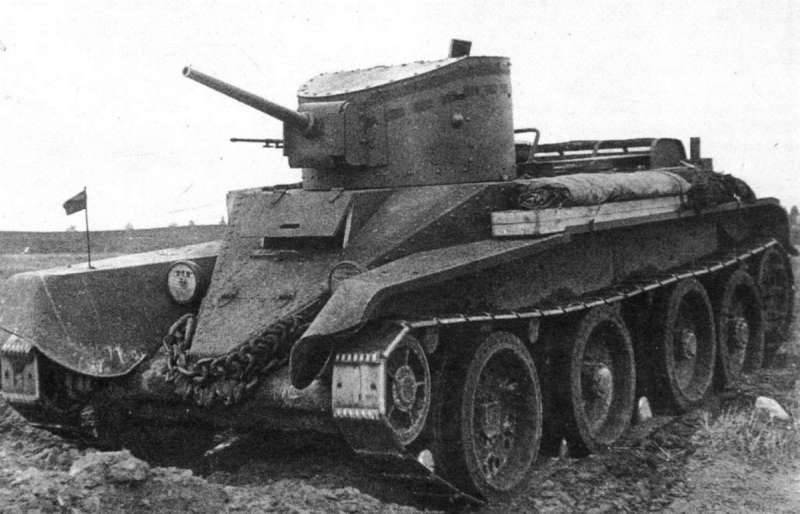
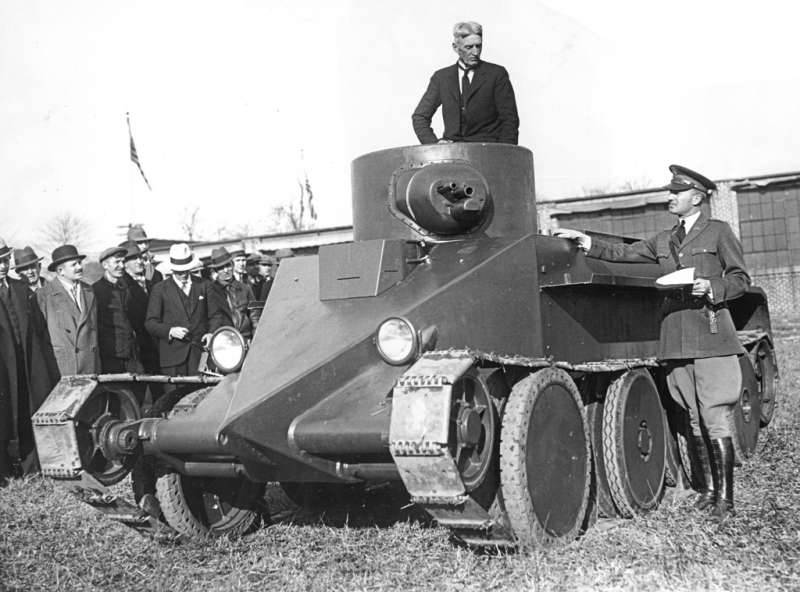
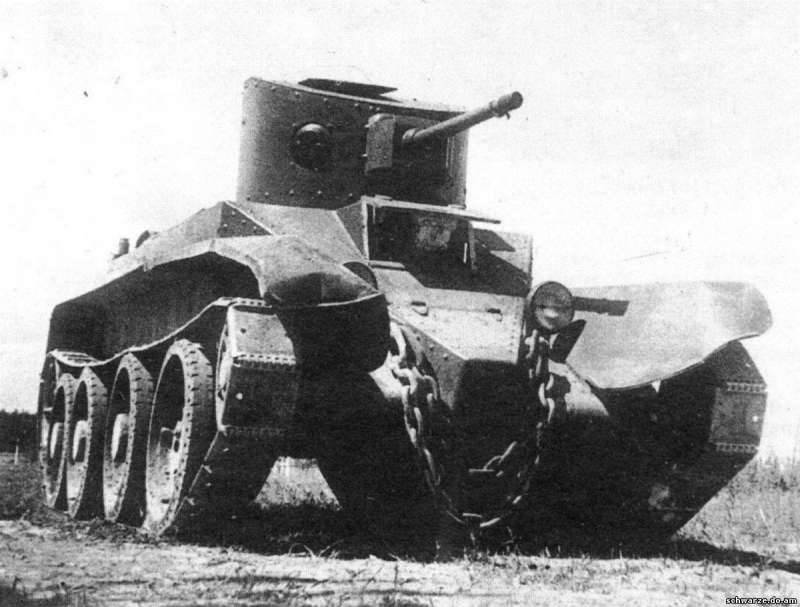
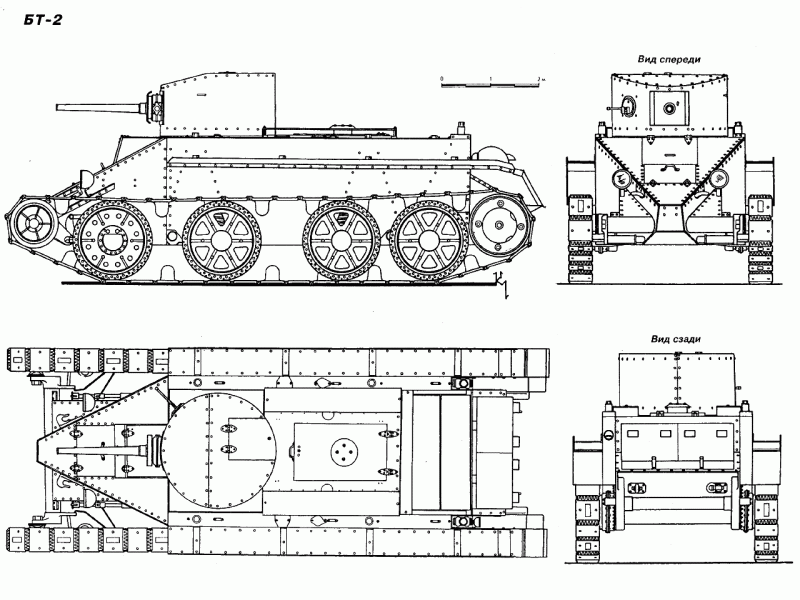
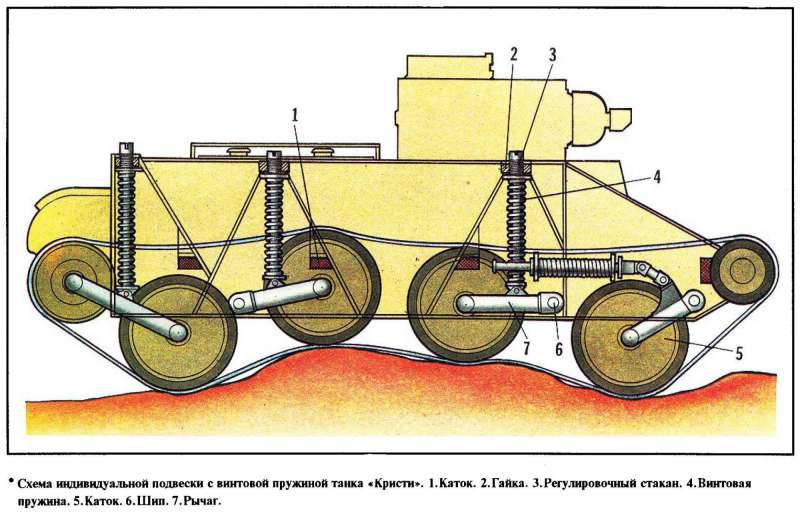
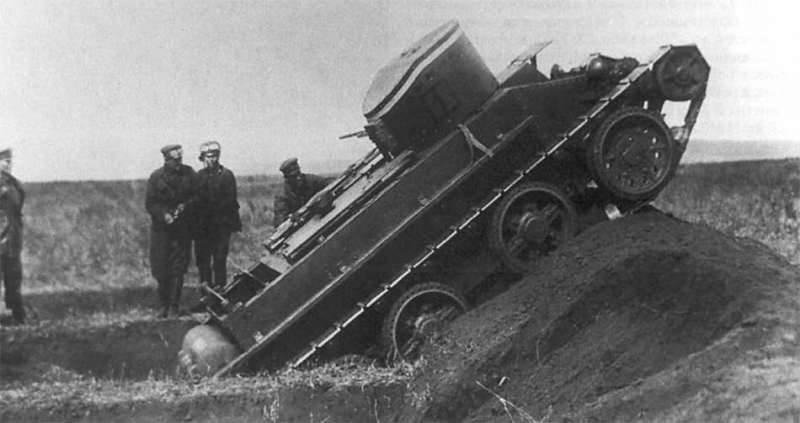
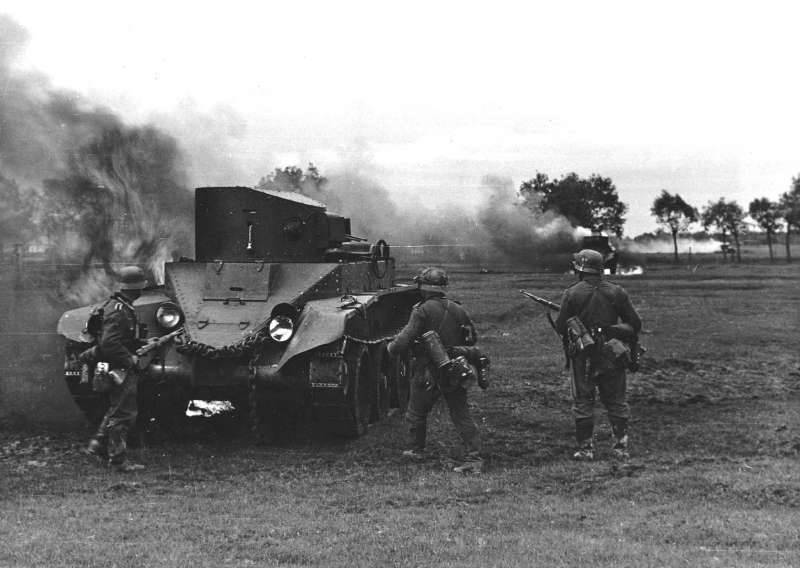
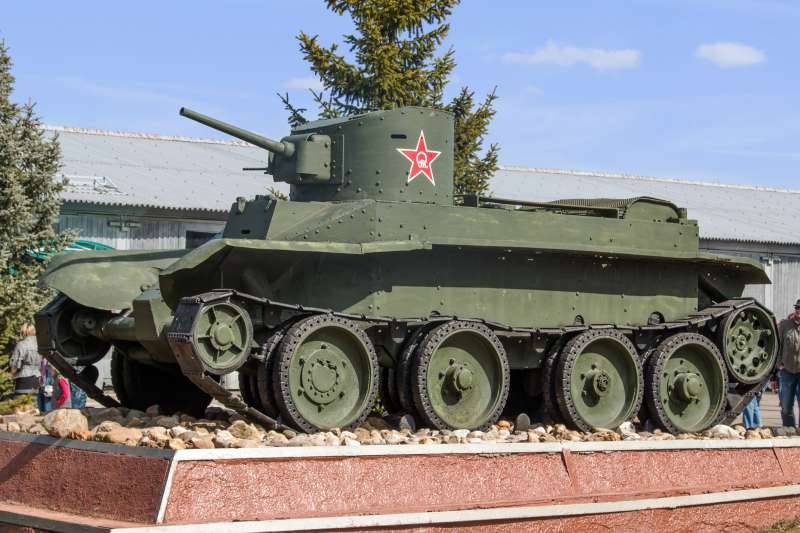
Information